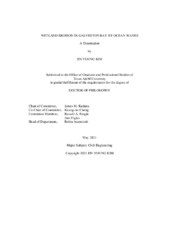| dc.description.abstract | Wave energy has been identified as a major cause of wetland edge erosion in general. This dissertation focuses on the numerical modeling of wind-wave and sediment transport affecting erosion and accretion of salt marsh edges and experimental investigations on the relationship between wave and salt marsh edge erosion.
First, the physical aspect of cold front-induced waves on salt-marsh erosion was investigated. We modeled changes in water level and wave conditions during the passage of cold fronts on Galveston Island, Texas. We found that wind gusts and abrupt direction shifts produced high energy wave events, propagated toward the wetland edge during the simulation period. Field measurements agreed with the modeled predictions in terms of both tidal water level and significant wave heights. We also calculated the wave power during the entire measurement period and found that cold front-induced waves significantly increased the potential erosion of salt marsh edges.
Second, a laboratory experiment investigated the resistance of the salt marsh to wave energy. Wave properties affecting salt marsh core samples were investigated. The wave power of the input waves was calculated based on spectrum analysis. Then the relationship between wave power and erosion rate was discussed based on dimensional analysis. As the input wave height increased, erosion generally increased, and more erosion was found in the portion of the samples where the wave breaking was frequent.
Third, surveys using Unmanned Aerial Vehicle (UAV) were conducted to identify salt marsh boundary erosion and potential wind-wave vulnerability. Using UAV images and Global Navigation Satellite System receivers, the wetland areas located on the bay side of Galveston Bay were photographed over a year to observe the change in the boundary. Erosion rates have been calculated for several wetlands on Galveston Island. An average of 0.76 m of lateral erosion was recorded over the measurement period. Through the wave simulation during this period, the relationship between wave energy and erosion rate was derived.
Lastly, sediment transport and processes along the wetland edge were investigated based on the large scale and detailed model. Sediment fluxes along the Galveston Bay entrance and West Bay area were quantified during the cold front passages. Erosion and accretion along the salt marsh boundary by tides, currents, and waves were investigated. In the relative sea level rise simulation model, it was found that the wetland edge region had the ability to adapt to a relatively high sea level, not lowering their platform level significantly. | en |


